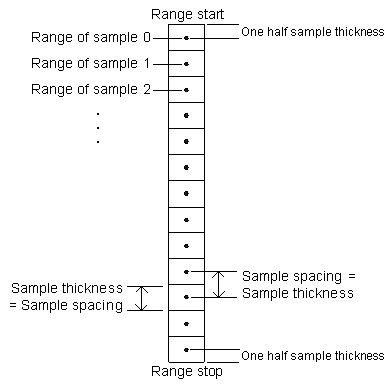About start and stop ranges
The start and stop ranges are values used to describe the extent of a ping (or beam). That is, the samples which constitute a ping are considered to describe the space between the start range and stop range from the transducer face.
You will find the start and stop range:
-
reported in exported data (as Range_Start and Range_Stop)
-
required in text data files (as Range_Start and Range_Stop)
-
reported under Ping (from file) on the Details dialog box (F9)
Given the start and stop range of a ping (or beam) and a count of samples in that ping (or beam) it is possible to calculate the range of each sample. See Calculating range and depth from exported data for an explanation. This is often all that is stored in a data file.
Each sample in a ping is taken at a specific time and represents a measured signal at that time (time is translated to range from the transducer by the relation r=ct/2, where c=sound speed, t=time and r=range). The time (space) between samples is allocated to the sample on equally either side, such that a sample is said to have thickness. Its thickness is equal to the spacing between samples (one half sample spacing before the sample, one half after) and this is termed the sample thickness.
This is illustrated below:

When Echoview applies a time varied gain (TVG) to samples, the range which is used is the range of the sample as illustrated above. That is, the range at the center of the sample. Some echosounders apply a correction to this range before calculating the time varied gain. See Simrad Time Varied Gain Range Correction and TVG_range_correction_algorithms.
See also
Calculating range and depth from exported data
Simrad Time Varied Gain Range Correction
TVG_range_correction_algorithms
About time varied gain